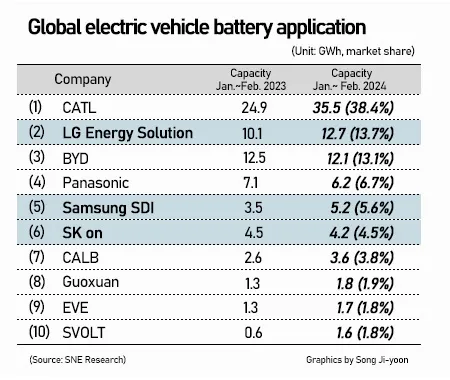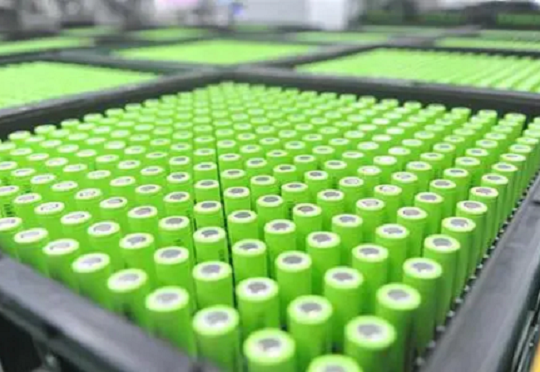time:2024-04-11 source:动力电池网
On April 8th, South Korean research firm SNE Research released global power battery statistics, showing that LG's new energy power battery installed capacity in the first two months of this year was 12.7 GWh, exceeding BYD's installed capacity of 12.1 GWh. The two companies are ranked second and third on the list respectively, with a ranking swap compared to January this year.
BYD's power battery installation volume exceeded 100GWh for the first time last year, with a market share of 15.8%, surpassing LG New Energy and ranking second in the world. Previously, in 2022, BYD and LG New Energy ranked second globally. The growth rate of BYD's power battery installation in the first two months of this year decreased by 3%, while the growth rate of LG New Energy in the same period was 24.8%. SNE analysis shows that due to the impact of the Spring Festival holiday, BYD's sales of new energy vehicles have decreased, leading to negative growth in its power battery installation.

According to data previously disclosed by BYD, the company sold 323800 new energy vehicles in the first two months of this year, a year-on-year decrease of 6.14%. SNE has pointed out that BYD has a competitive advantage in price through its power battery self supply system and vertical integration strategy, and has a high popularity in the Chinese new energy vehicle market.
In the first two months of this year, CATL continued to rank first in global power vehicle installation volume. Its power battery installed on vehicles is 35.5 GWh, a year-on-year increase of 44.9%, with a market share of 38.4%, which is nearly five percentage points higher than the same period last year. Ningde Times has been ranked first in the global power battery installation volume for seven consecutive years. Last year, the company was the only enterprise in the world with a vehicle installation volume exceeding 200GWh, with a global market share of 36.8%. If calculated based on each new energy vehicle carrying 50 KWh of electricity (50 kWh), a 200 GWh power battery can support approximately 4 million new energy vehicles.
In addition, although Panasonic in Japan decreased by 11.8% year-on-year, it still ranks fourth in the top 10 global power battery installations, with a market share of 6.7%; South Korean battery companies Samsung SDI and SK On ranked fifth and sixth respectively, with market share of 5.6% and 4.5%, respectively; Zhongchuangxin Aviation, Guoxuan High tech, Yiwei Lithium Energy, and Beehive Energy rank seventh to tenth respectively, with market share of 3.8%, 1.9%, 1.8%, and 1.8%. It is worth noting that Honeycomb Energy has become the only battery company in the top 10 to show triple digit growth with a year-on-year growth rate of 184.3%.
In addition, among the top 10 global power battery installation companies from January to February, three of them showed a negative year-on-year growth rate. According to SNE analysis, as the demand growth in the global electric vehicle market begins to slow down, some long-term growing companies are experiencing negative year-on-year growth in battery usage. However, this is analyzed as a temporary phenomenon due to the delay in the final determination of subsidies for electric vehicles in China and the decrease in working days caused by the Spring Festival, resulting in a decline in electric vehicle sales. In the future, with the resolution of deferred demand and the increase in sales of electric vehicles, battery usage is expected to resume growth again.

Previously, SNE analyzed that Chinese battery companies are showing a similar global market expansion trend to automobile manufacturers, with a significant increase in market share. Analysis suggests that the main factor contributing to the expansion of global market share for Chinese battery companies is the leap in lithium iron phosphate batteries. Due to the recent slowdown in the global electric vehicle market growth, the proportion of cost competitive lithium iron phosphate batteries is gradually increasing, especially in the entry-level electric vehicle market.
The lithium iron phosphate battery, which was previously only considered a low-priced battery made in China, began to grow rapidly after news of Tesla's lithium iron phosphate battery spread. It was first installed on the Model 3 and has now expanded to the Model Y. In addition, in the process of popularizing electric vehicles, the relative safety advantage of lithium iron phosphate batteries over ternary lithium batteries is also one of the reasons for their increased adoption. At present, Chinese representative enterprises leading lithium iron phosphate batteries include CATL, BYD, and Guoxuan High tech, all of which are actively targeting overseas markets.